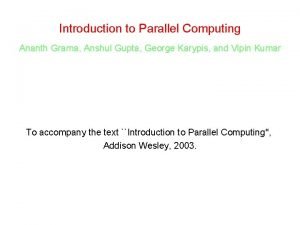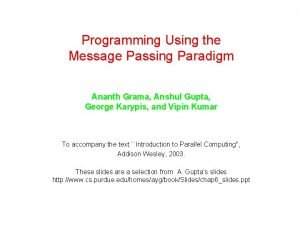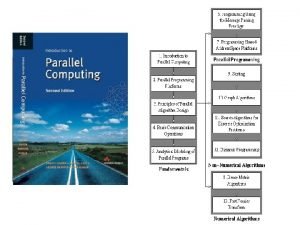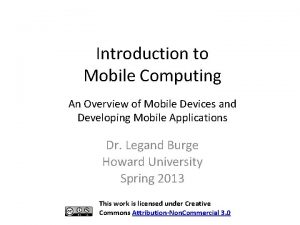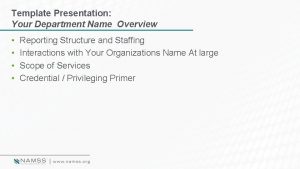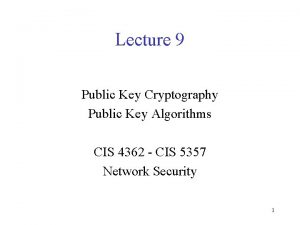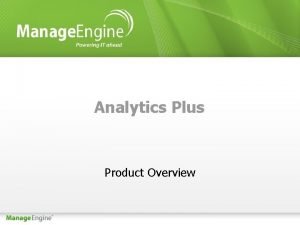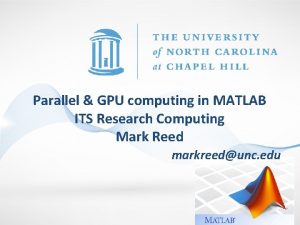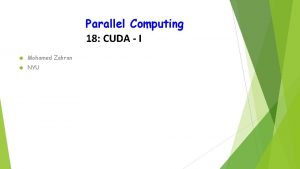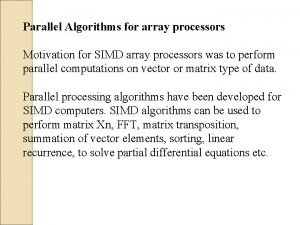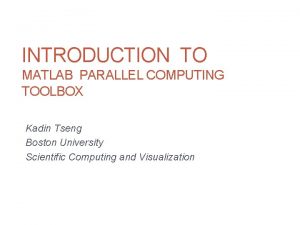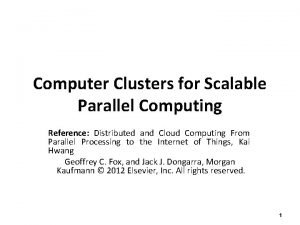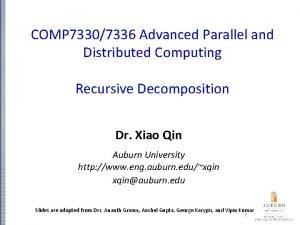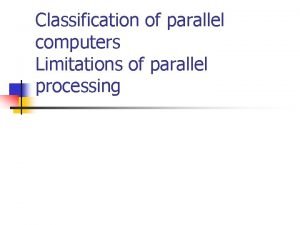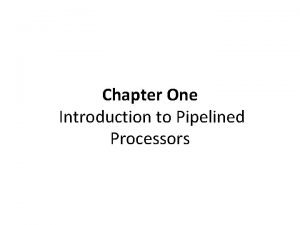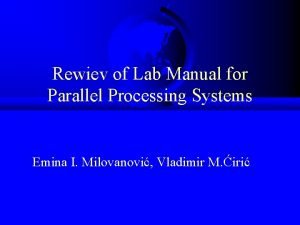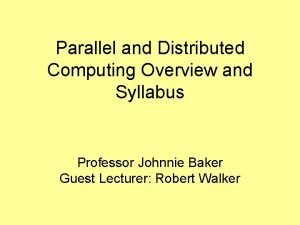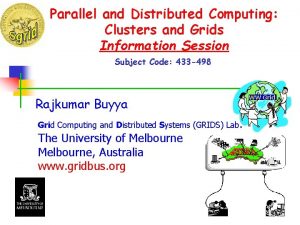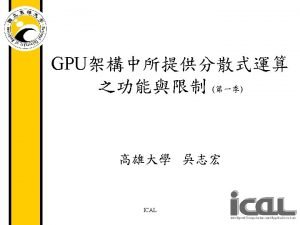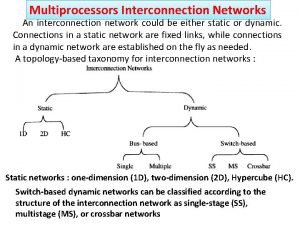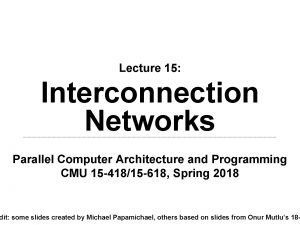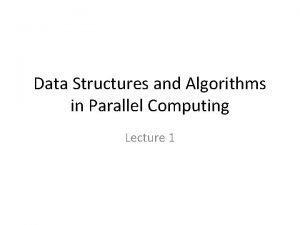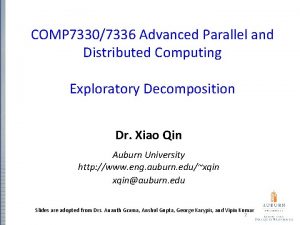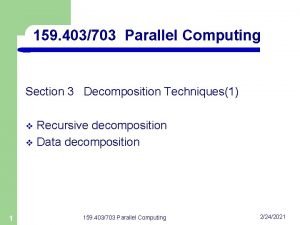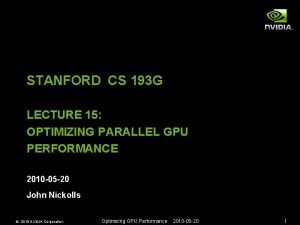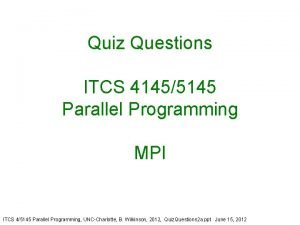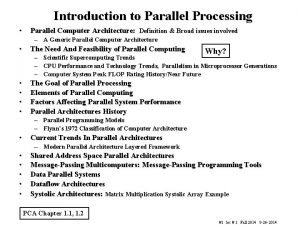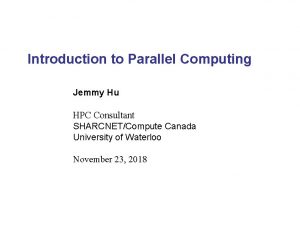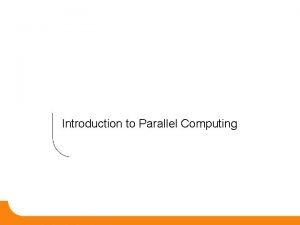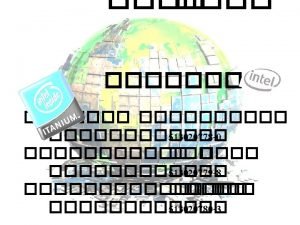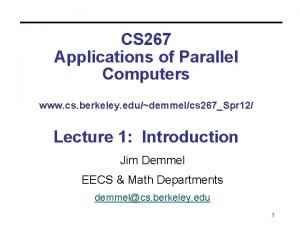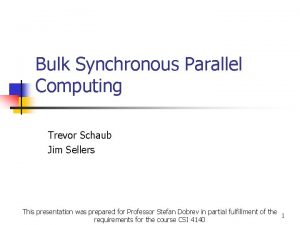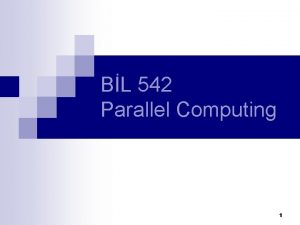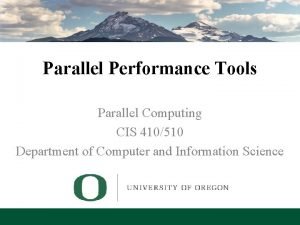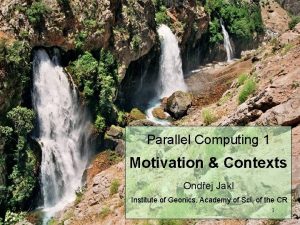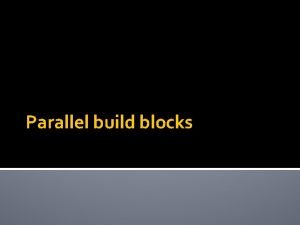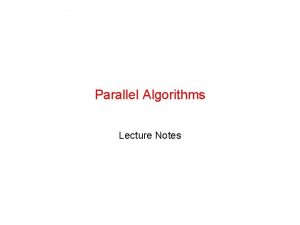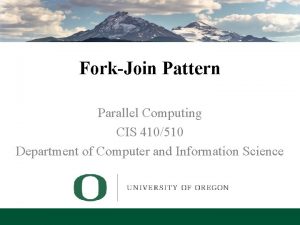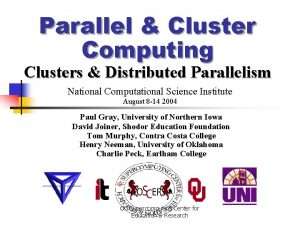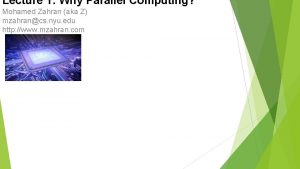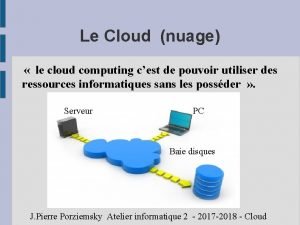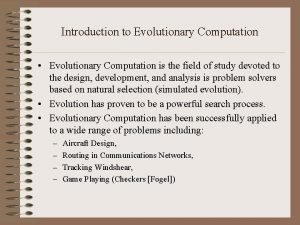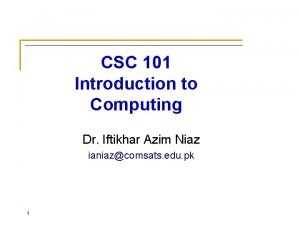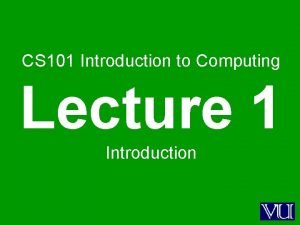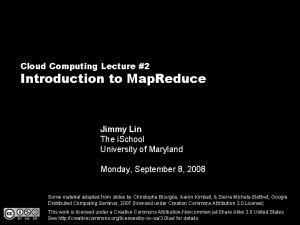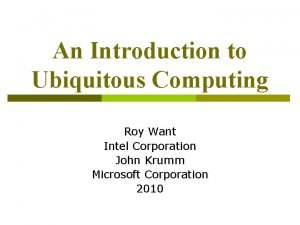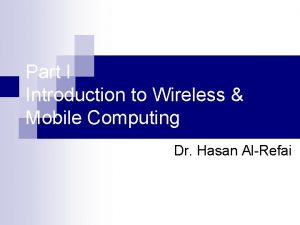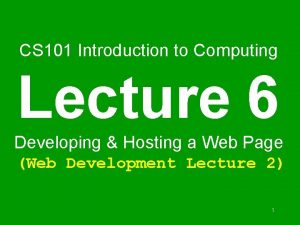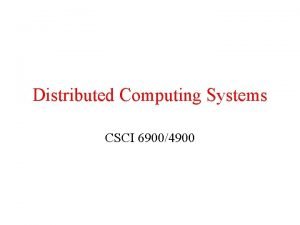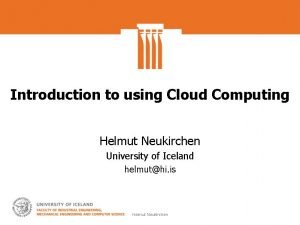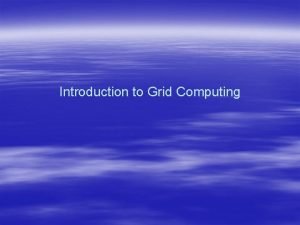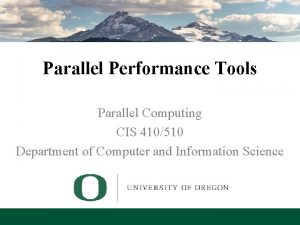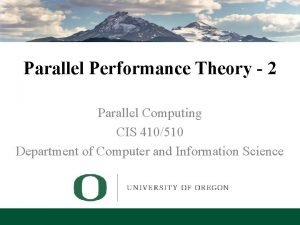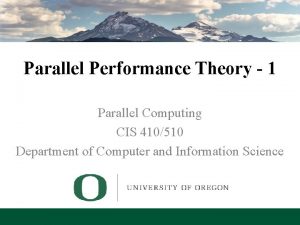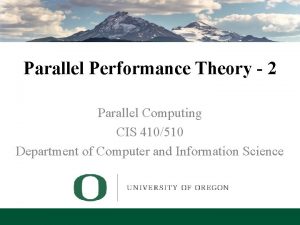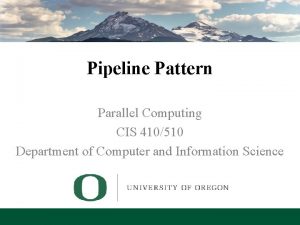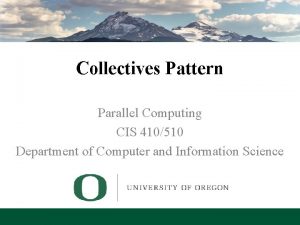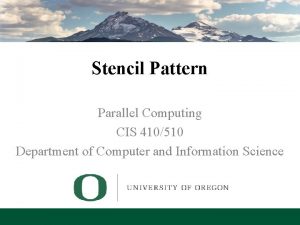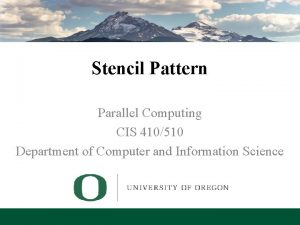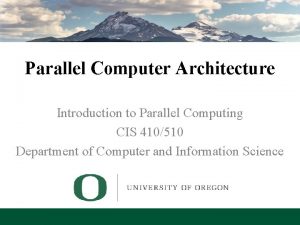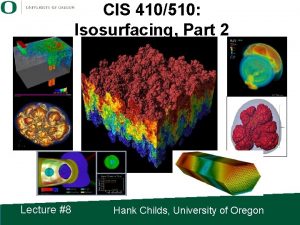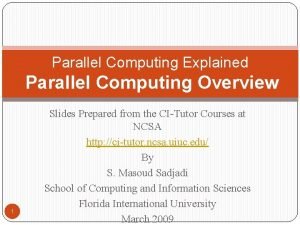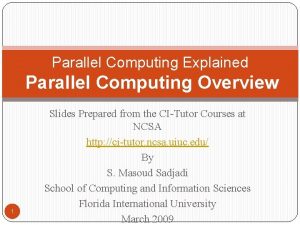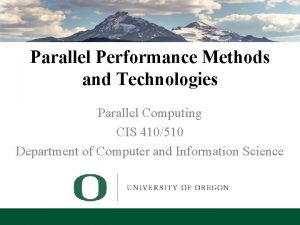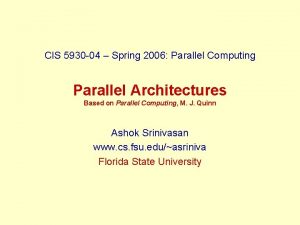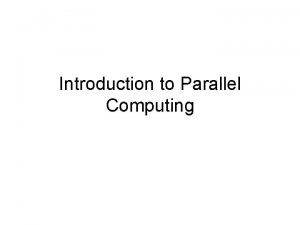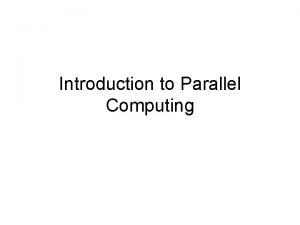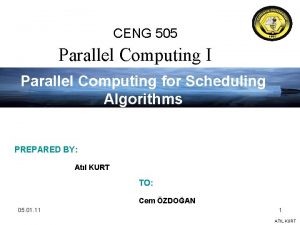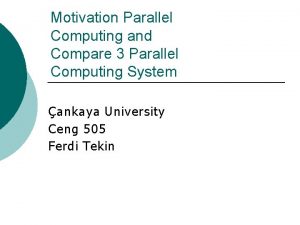Overview Introduction to Parallel Computing CIS 410510 Department

































































- Slides: 65

Overview Introduction to Parallel Computing CIS 410/510 Department of Computer and Information Science Lecture 1 – Overview

Outline q Course Overview ❍ What is CIS 410/510? ❍ What is expected of you? ❍ What will you learn in CIS 410/510? q Parallel Computing ❍ What is it? ❍ What motivates it? ❍ Trends that shape the field ❍ Large-scale problems and high-performance ❍ Parallel architecture types ❍ Scalable parallel computing and performance Introduction to Parallel Computing, University of Oregon, IPCC Lecture 1 – Overview 2

How did the idea for CIS 410/510 originate? q q q There has never been an undergraduate course in parallel computing in the CIS Department at UO Only 1 course taught at the graduate level (CIS 631) Goal is to bring parallel computing education in CIS undergraduate curriculum, start at senior level CIS 410/510 (Spring 2014, “experimental” course) ❍ CIS 431/531 (Spring 2015, “new” course) ❍ q CIS 607 – Parallel Computing Course Development Winter 2014 seminar to plan undergraduate course ❍ Develop 410/510 materials, exercises, labs, … ❍ q q Intel gave a generous donation ($100 K) to the effort NSF and IEEE are spearheading a curriculum initiative for undergraduate education in parallel processing http: //www. cs. gsu. edu/~tcpp/curriculum/ Introduction to Parallel Computing, University of Oregon, IPCC Lecture 1 – Overview 3

Who’s involved? q Instructor ❍ Allen D. Malony ◆scalable parallel computing ◆parallel performance analysis ◆taught CIS 631 for the last 10 years q Faculty colleagues and course co-designers ❍ Boyana Norris ◆Automated software analysis and transformation ◆Performance analysis and optimization ❍ Hank Childs ◆Large-scale, parallel scientific visualization ◆Visualization of large data sets q Intel scientists ❍ q Michael Mc. Cool, James Reinders, Bob Mac. Kay Graduate students doing research in parallel computing Introduction to Parallel Computing, University of Oregon, IPCC Lecture 1 – Overview 4

Intel Partners q James Reinders ❍ Director, Software Products ❍ Multi-core Evangelist q Michael Mc. Cool ❍ Software architect ❍ Former Chief scientist, Rapid. Mind ❍ Adjunct Assoc. Professor, University of Waterloo q Arch Robison ❍ Architect of Threading Building Blocks ❍ Former lead developers of KAI C++ q David Mac. Kay ❍ Manager of software product consulting team Introduction to Parallel Computing, University of Oregon, IPCC Lecture 1 – Overview 5

CIS 410/510 Graduate Assistants q Daniel Ellsworth ❍ 3 rd year Ph. D. student ❍ Research advisor (Prof. Malony) ❍ Large-scale online system introspection q David Poliakoff ❍ 2 nd year Ph. D. student ❍ Research advisor (Prof. Malony) ❍ Compiler-based performance analysis q Brandon Hildreth ❍ 1 st year Ph. D. student ❍ Research advisor (Prof. Malony) ❍ Automated performance experimentation Introduction to Parallel Computing, University of Oregon, IPCC Lecture 1 – Overview 6

Required Course Book q q “Structured Parallel Programming: Patterns for Efficient Computation, ” Michael Mc. Cool, Arch Robinson, James Reinders, 1 st edition, Morgan Kaufmann, ISBN: 978 -0 -12 -415993 -8, 2012 http: //parallelbook. com/ Presents parallel programming from a point of view of patterns relevant to parallel computation ❍ q Map, Collectives, Data reorganization, Stencil and recurrence, Fork-Join, Pipeline Focuses on the use of shared memory parallel programming languages and environments ❍ ❍ Intel Thread Building Blocks (TBB) Intel Cilk Plus Introduction to Parallel Computing, University of Oregon, IPCC Lecture 1 – Overview 7

Reference Textbooks q Introduction to Parallel Computing, A. Grama, A. Gupta, G. Karypis, V. Kumar, Addison Wesley, 2 nd Ed. , 2003 ❍ ❍ q Designing and Building Parallel Programs, Ian Foster, Addison Wesley, 1995. ❍ ❍ q Lecture slides from authors online Excellent reference list at end Used for CIS 631 before Getting old for latest hardware Entire book is online!!! Historical book, but very informative Patterns for Parallel Programming T. Mattson, B. Sanders, B. Massingill, Addison Wesley, 2005. ❍ ❍ ❍ Targets parallel programming Pattern language approach to parallel program design and development Excellent references Introduction to Parallel Computing, University of Oregon, IPCC Lecture 1 – Overview 8

What do you mean by experimental course? Given that this is the first offering of parallel computing in the undergraduate curriculum, we want to evaluate how well it worked q We would like to receive feedback from students throughout the course q ❍ Lecture content and understanding ❍ Parallel programming learning experience ❍ Book and other materials q Your experiences will help to update the course for it debut offering in (hopefully) Spring 2015 Introduction to Parallel Computing, University of Oregon, IPCC Lecture 1 – Overview 9

Course Plan q Organize the course so that cover main areas of parallel computing in the lectures ❍ Architecture (1 week) ❍ Performance models and analysis (1 week) ❍ Programming patterns (paradigms) (3 weeks) ❍ Algorithms (2 weeks) ❍ Tools (1 week) ❍ Applications (1 week) ❍ Special topics (1 week) q Augment lecture with a programming lab ❍ Students will take the lab with the course ◆graded assignments and term project will be posted ❍ Targeted specifically to shared memory parallelism Introduction to Parallel Computing, University of Oregon, IPCC Lecture 1 – Overview 10

Lectures q q Book and online materials are you main sources for broader and deeper background in parallel computing Lectures should be more interactive ❍ Supplement other sources of information ❍ Covers topics of more priority ❍ Intended to give you some of my perspective ❍ Will provide online access to lecture slides q q Lectures will complement programming component, but intended to cover other parallel computing aspects Try to arrange a guest lecture or 2 during quarter Introduction to Parallel Computing, University of Oregon, IPCC Lecture 1 – Overview 11

Parallel Programming Lab q Set up in the IPCC classroom ❍ q Daniel Ellsworth and David Poliakoff leading the lab Shared memory parallel programming (everyone) ❍ Cilk Plus ( http: //www. cilkplus. org/ ) ◆extension to the C and C++ languages to support data and task parallelism ❍ Thread Building Blocks (TBB) (https: //www. threadingbuildingblocks. org/ ) ◆C++ template library for task parallelism ❍ Open. MP (http: //openmp. org/wp/ ) ◆C/C++ and Fortran directive-based parallelism q Distributed memory message passing (graduate) ❍ MPI (http: //en. wikipedia. org/wiki/Message_Passing_Interface ) ◆library for message communication on scalable parallel systems Introduction to Parallel Computing, University of Oregon, IPCC Lecture 1 – Overview 12

WOPR (What Operational Parallel Resource) q WOPR was built from whole cloth ❍ Constructed q by UO graduate students Built Next Unit of Computing (NUC) cluster with Intel funds ❍ 16 x Intel NUC ◆Haswell i 5 CPU (2 cores, hyperthreading) ◆Intel HD 4000 GPU (Open. CL programmable) ◆1 Gig. E, 16 GB memory, 240 GB m. SATA ◆16 x Logitech keyboard and mouse ❍ 16 x View. Sonic 22” monitor ❍ Dell Edge Gig. E switch ❍ Dell head node Introduction to Parallel Computing, University of Oregon, IPCC Lecture 1 – Overview 13

Other Parallel Resources – Mist Cluster Distributed memory cluster q 16 8 -core nodes q ❍ 2 x quad-core Pentium Xeon (2. 33 GHz) ❍ 16 Gbyte memory ❍ 160 Gbyte disk Dual Gigabit ethernet adaptors q Master node (same specs) q Gigabit ethernet switch q mist. nic. uoregon. edu q Introduction to Parallel Computing, University of Oregon, IPCC Lecture 1 – Overview 14

Other Parallel Resources – ACISS Cluster q Applied Computational Instrument for Scientific Synthesis ❍ q NSF MRI R 2 award (2010) Basic nodes (1, 536 total cores) ❍ ❍ ❍ 128 Pro. Liant SL 390 G 7 Two Intel X 5650 2. 66 GHz 6 -core CPUs per node 72 GB DDR 3 RAM per basic node q Fat nodes (512 total cores) q 16 Pro. Liant DL 580 G 7 ❍ Four Intel X 7560 2. 266 GHz 8 -core CPUs per node ❍ 384 GB DDR 3 per fat node GPU nodes (624 total cores, 156 GPUs) ❍ 52 Pro. Liant SL 390 G 7 nodes, 3 NVidia M 2070 GPUs (156 total GPUs) Two Intel X 5650 2. 66 GHz 6 -core CPUs per node (624 total cores) 72 GB DDR 3 per GPU node ACISS has 2672 total cores q ACISS is located in the UO Computing Center Introduction to Parallel Computing, University of Oregon, IPCC Lecture 1 – Overview 15

Course Assignments q Homework ❍ q Exercises primarily to prepare for midterm Parallel programming lab Exercises for parallel programming patterns ❍ Program using Cilk Plus, Thread Building Blocks, Open. MP ❍ Graduate students will also do assignments with MPI ❍ q Team term project Programming, presentation, paper ❍ Graduate students distributed across teams ❍ q q q Research summary paper (graduate students) Midterm exam later in the 7 th week of the quarter No final exam ❍ Team project presentations during final period Introduction to Parallel Computing, University of Oregon, IPCC Lecture 1 – Overview 16

Parallel Programming Term Project q Major programming project for the course ❍ Non-trivial parallel application ❍ Include performance analysis ❍ Use NUC cluster and possibly Mist and ACISS clusters q Project teams ❍5 person teams, 6 teams (depending on enrollment) ❍ Will try our best to balance skills ❍ Have 1 graduate student per team q Project dates ❍ Proposal due end of 4 th week) ❍ Project talk during last class ❍ Project due at the end of the term q Need to get system accounts!!! Introduction to Parallel Computing, University of Oregon, IPCC Lecture 1 – Overview 17

Term Paper (for graduate students) q Investigate parallel computing topic of interest ❍ More in depth review ❍ Individual choice ❍ Summary of major points q Requires minimum of ten references ❍ Book and other references has a large bibliography ❍ Google Scholar, Keywords: parallel computing ❍ NEC Cite. Seer Scientific Literature Digital Library q q q Paper abstract and references due by 3 rd week Final term paper due at the end of the term Individual work Introduction to Parallel Computing, University of Oregon, IPCC Lecture 1 – Overview 18

Grading q Undergraduate ❍ 5% ❍ 10% ❍ 20% ❍ 35% q homework pattern programming labs programming assignments midterm exam project Graduate ❍ 15% ❍ 30% ❍ 35% ❍ 20% programming assignments midterm exam project research paper Introduction to Parallel Computing, University of Oregon, IPCC Lecture 1 – Overview 19

Overview q Broad/Old field of computer science concerned with: ❍ Architecture, HW/SW systems, languages, programming paradigms, algorithms, and theoretical models ❍ Computing in parallel q Performance is the raison d’être for parallelism ❍ High-performance computing ❍ Drives computational science revolution q Topics of study ❍ Parallel architectures ❍ Parallel programming ❍ Parallel algorithms Introduction to Parallel Computing, University of Oregon, IPCC Parallel performance models and tools Parallel applications Lecture 1 – Overview 20

What will you get out of CIS 410/510? In-depth understanding of parallel computer design q Knowledge of how to program parallel computer systems q Understanding of pattern-based parallel programming q Exposure to different forms parallel algorithms q Practical experience using a parallel cluster q Background on parallel performance modeling q Techniques for empirical performance analysis q Fun and new friends q Introduction to Parallel Computing, University of Oregon, IPCC Lecture 1 – Overview 21

Parallel Processing – What is it? q q A parallel computer is a computer system that uses multiple processing elements simultaneously in a cooperative manner to solve a computational problem Parallel processing includes techniques and technologies that make it possible to compute in parallel ❍ Hardware, networks, operating systems, parallel libraries, languages, compilers, algorithms, tools, … q Parallel computing is an evolution of serial computing ❍ Parallelism is natural ❍ Computing problems differ in level / type of parallelism q Parallelism is all about performance! Really? Introduction to Parallel Computing, University of Oregon, IPCC Lecture 1 – Overview 22

Concurrency q q Consider multiple tasks to be executed in a computer Tasks are concurrent with respect to each if ❍ They can execute at the same time (concurrent execution) ❍ Implies that there are no dependencies between the tasks q Dependencies ❍ If a task requires results produced by other tasks in order to execute correctly, the task’s execution is dependent ❍ If two tasks are dependent, they are not concurrent ❍ Some form of synchronization must be used to enforce (satisfy) dependencies q Concurrency is fundamental to computer science ❍ Operating systems, databases, networking, … Introduction to Parallel Computing, University of Oregon, IPCC Lecture 1 – Overview 23

Concurrency and Parallelism q q Concurrent is not the same as parallel! Why? Parallel execution ❍ Concurrent tasks actually execute at the same time ❍ Multiple (processing) resources have to be available q Parallelism = concurrency + “parallel” hardware ❍ Both are required ❍ Find concurrent execution opportunities ❍ Develop application to execute in parallel ❍ Run application on parallel hardware q q Is a parallel application a concurrent application? Is a parallel application run with one processor parallel? Why or why not? Introduction to Parallel Computing, University of Oregon, IPCC Lecture 1 – Overview 24

Parallelism q There are granularities of parallelism (parallel execution) in programs ❍ Processes, threads, routines, statements, instructions, … ❍ Think about what are the software elements that execute concurrently q These must be supported by hardware resources ❍ Processors, cores, … (execution of instructions) ❍ Memory, DMA, networks, … (other associated operations) ❍ All aspects of computer architecture offer opportunities for parallel hardware execution q Concurrency is a necessary condition for parallelism ❍ Where can you find concurrency? ❍ How is concurrency expressed to exploit parallel systems? Introduction to Parallel Computing, University of Oregon, IPCC Lecture 1 – Overview 25

Why use parallel processing? q Two primary reasons (both performance related) Faster time to solution (response time) ❍ Solve bigger computing problems (in same time) ❍ q Other factors motivate parallel processing Effective use of machine resources ❍ Cost efficiencies ❍ Overcoming memory constraints ❍ q Serial machines have inherent limitations ❍ q q q Processor speed, memory bottlenecks, … Parallelism has become the future of computing Performance is still the driving concern Parallelism = concurrency + parallel HW + performance Introduction to Parallel Computing, University of Oregon, IPCC Lecture 1 – Overview 26

Perspectives on Parallel Processing q Parallel computer architecture Hardware needed for parallel execution? ❍ Computer system design ❍ q (Parallel) Operating system ❍ q How to manage systems aspects in a parallel computer Parallel programming Libraries (low-level, high-level) ❍ Languages ❍ Software development environments ❍ q q q Parallel algorithms Parallel performance evaluation Parallel tools ❍ Performance, analytics, visualization, … Introduction to Parallel Computing, University of Oregon, IPCC Lecture 1 – Overview 27

Why study parallel computing today? q Computing architecture ❍ q Innovations often drive to novel programming models Technological convergence The “killer micro” is ubiquitous ❍ Laptops and supercomputers are fundamentally similar! ❍ Trends cause diverse approaches to converge ❍ q Technological trends make parallel computing inevitable Multi-core processors are here to stay! ❍ Practically every computing system is operating in parallel ❍ q Understand fundamental principles and design tradeoffs Programming, systems support, communication, memory, … ❍ Performance ❍ q Parallelism is the future of computing Introduction to Parallel Computing, University of Oregon, IPCC Lecture 1 – Overview 28

Inevitability of Parallel Computing q Application demands ❍ Insatiable q Technology trends ❍ Processor q q q need for computing cycles and memory Architecture trends Economics Current trends: ❍ Today’s microprocessors have multiprocessor support ❍ Servers and workstations available as multiprocessors ❍ Tomorrow’s microprocessors are multiprocessors ❍ Multi-core is here to stay and #cores/processor is growing ❍ Accelerators (GPUs, gaming systems) Introduction to Parallel Computing, University of Oregon, IPCC Lecture 1 – Overview 29

Application Characteristics q q q Application performance demands hardware advances Hardware advances generate new applications New applications have greater performance demands ❍ Exponential increase in microprocessor performance ❍ Innovations in parallel architecture and integration applications q Range of performance requirements performance hardware ❍ System performance must also improve as a whole ❍ Performance requirements require computer engineering ❍ Costs addressed through technology advancements Introduction to Parallel Computing, University of Oregon, IPCC Lecture 1 – Overview 30

Broad Parallel Architecture Issues q Resource allocation ❍ How many processing elements? ❍ How powerful are the elements? ❍ How much memory? q Data access, communication, and synchronization ❍ How do the elements cooperate and communicate? ❍ How are data transmitted between processors? ❍ What are the abstractions and primitives for cooperation? q Performance and scalability ❍ How does it all translate into performance? ❍ How does it scale? Introduction to Parallel Computing, University of Oregon, IPCC Lecture 1 – Overview 31

Leveraging Moore’s Law More transistors = more parallelism opportunities q Microprocessors q ❍ Implicit parallelism ◆pipelining ◆multiple functional units ◆superscalar ❍ Explicit parallelism ◆SIMD instructions ◆long instruction works Introduction to Parallel Computing, University of Oregon, IPCC Lecture 1 – Overview 32

What’s Driving Parallel Computing Architecture? von Neumann bottleneck!! (memory wall) Introduction to Parallel Computing, University of Oregon, IPCC Lecture 1 – Overview 33

Microprocessor Transitor Counts (1971 -2011) Introduction to Parallel Computing, University of Oregon, IPCC Lecture 1 – Overview 34

What has happened in the last several years? q Processing chip manufacturers increased processor performance by increasing CPU clock frequency ❍ Riding q Moore’s law Until the chips got too hot! clock frequency greater electrical power ❍ Pentium 4 heat sink Frying an egg on a Pentium 4 ❍ Greater q Add multiple cores to add performance ❍ Keep clock frequency same or reduced ❍ Keep lid on power requirements Introduction to Parallel Computing, University of Oregon, IPCC Lecture 1 – Overview 35

Power Density Growth Figure courtesy of Pat Gelsinger, Intel Developer Forum, Spring 2004 Introduction to Parallel Computing, University of Oregon, IPCC Lecture 1 – Overview 36

What’s Driving Parallel Computing Architecture? Introduction to Parallel Computing, University of Oregon, IPCC Lecture 1 – Overview 37

What’s Driving Parallel Computing Architecture? power wall Introduction to Parallel Computing, University of Oregon, IPCC Lecture 1 – Overview 38

Classifying Parallel Systems – Flynn’s Taxonomy q Distinguishes multi-processor computer architectures along the two independent dimensions ❍ Instruction and Data ❍ Each dimension can have one state: Single or Multiple q SISD: Single Instruction, Single Data ❍ Serial q (non-parallel) machine SIMD: Single Instruction, Multiple Data ❍ Processor q q arrays and vector machines MISD: Multiple Instruction, Single Data (weird) MIMD: Multiple Instruction, Multiple Data ❍ Most common parallel computer systems Introduction to Parallel Computing, University of Oregon, IPCC Lecture 1 – Overview 39

Parallel Architecture Types q Instruction-Level Parallelism ❍ Parallelism q Vector processors ❍ Operations q captured in instruction processing on multiple data stored in vector registers Shared-memory Multiprocessor (SMP) ❍ Multiple processors sharing memory ❍ Symmetric Multiprocessor (SMP) q Multicomputer ❍ Multiple computer connect via network ❍ Distributed-memory cluster q Massively Parallel Processor (MPP) Introduction to Parallel Computing, University of Oregon, IPCC Lecture 1 – Overview 40

Phases of Supercomputing (Parallel) Architecture q q Phase 1 (1950 s): sequential instruction execution Phase 2 (1960 s): sequential instruction issue ❍ Pipeline execution, reservations stations ❍ Instruction Level Parallelism (ILP) q Phase 3 (1970 s): vector processors ❍ Pipelined arithmetic units ❍ Registers, multi-bank (parallel) memory systems q q Phase 4 (1980 s): SIMD and SMPs Phase 5 (1990 s): MPPs and clusters ❍ Communicating q sequential processors Phase 6 (>2000): many cores, accelerators, scale, … Introduction to Parallel Computing, University of Oregon, IPCC Lecture 1 – Overview 41

Performance Expectations q q q If each processor is rated at k MFLOPS and there are p processors, we should expect to see k*p MFLOPS performance? Correct? If it takes 100 seconds on 1 processor, it should take 10 seconds on 10 processors? Correct? Several causes affect performance ❍ Each must be understood separately ❍ But they interact with each other in complex ways ◆solution to one problem may create another ◆one problem may mask another q q Scaling (system, problem size) can change conditions Need to understand performance space Introduction to Parallel Computing, University of Oregon, IPCC Lecture 1 – Overview 42

Scalability q A program can scale up to use many processors ❍ What does that mean? How do you evaluate scalability? q How do you evaluate scalability goodness? q Comparative evaluation q ❍ If double the number of processors, what to expect? ❍ Is scalability linear? q Use parallel efficiency measure ❍ Is q efficiency retained as problem size increases? Apply performance metrics Introduction to Parallel Computing, University of Oregon, IPCC Lecture 1 – Overview 43

Top 500 Benchmarking Methodology q q Listing of the world’s 500 most powerful computers Yardstick for high-performance computing (HPC) ❍ Rmax : maximal performance Linpack benchmark ◆dense linear system of equations (Ax = b) q Data listed ❍ Rpeak : theoretical peak performance ❍ Nmax : problem size needed to achieve Rmax ❍ N 1/2 : problem size needed to achieve 1/2 of Rmax ❍ Manufacturer and computer type ❍ Installation site, location, and year q Updated twice a year at SC and ISC conferences Introduction to Parallel Computing, University of Oregon, IPCC Lecture 1 – Overview 44

Top 10 (November 2013) Different architectures Introduction to Parallel Computing, University of Oregon, IPCC Lecture 1 – Overview 45

Top 500 – Performance (November 2013) Introduction to Parallel Computing, University of Oregon, IPCC Lecture 1 – Overview 46

#1: NUDT Tiahne-2 (Milkyway-2) q Compute Nodes have 3. 432 Tflop/s per node 16, 000 nodes ❍ 32000 Intel Xeon CPU ❍ 48000 Intel Xeon Phi ❍ q Operations Nodes ❍ q Proprietary interconnect ❍ q q TH 2 express 1 PB memory ❍ q 4096 FT CPUs Host memory only Global shared parallel storage is 12. 4 PB Cabinets: 125+13+24 =162 Compute, communication, storage ❍ ~750 m 2 ❍ Introduction to Parallel Computing, University of Oregon, IPCC Lecture 1 – Overview 47

#2: ORNL Titan Hybrid System (Cray XK 7) q Peak performance of 27. 1 PF ❍ q 18, 688 Compute Nodes each with: ❍ ❍ ❍ q q q 24. 5 GPU + 2. 6 CPU 16 -Core AMD Opteron CPU NVIDIA Tesla “K 20 x” GPU 32 + 6 GB memory 512 Service and I/O nodes 200 Cabinets 710 TB total system memory Cray Gemini 3 D Torus Interconnect 8. 9 MW peak power Introduction to Parallel Computing, University of Oregon, IPCC 4, 352 ft 2 Lecture 1 – Overview 48

#3: LLNL Sequoia (IBM BG/Q) q Compute card 16 -core Power. PC A 2 processor ❍ 16 GB DDR 3 ❍ q q Compute node has 98, 304 cards Total system size: 1, 572, 864 processing cores ❍ 1. 5 PB memory ❍ q q 5 -dimensional torus interconnection network Area of 3, 000 ft 2 Introduction to Parallel Computing, University of Oregon, IPCC Lecture 1 – Overview 49

#4: RIKEN K Computer q 80, 000 CPUs ❍ SPARC 64 VIIIfx ❍ 640, 000 cores 800 water-cooled racks q 5 D mesh/torus interconnect (Tofu) q ❍ 12 links between node ❍ 12 x higher scalability than 3 D torus Introduction to Parallel Computing, University of Oregon, IPCC Lecture 1 – Overview 50

Contemporary HPC Architectures Date System Location Comp Comm 2009 Jaguar; Cray XT 5 ORNL AMD 6 c Seastar 2 2. 3 7. 0 2010 Tianhe-1 A NSC Tianjin Intel + NVIDIA Proprietary 4. 7 4. 0 2010 Nebulae NSCS Shenzhen Intel + NVIDIA IB 2. 9 2. 6 2010 Tsubame 2 Ti. Tech Intel + NVIDIA IB 2. 4 1. 4 2011 K Computer RIKEN/Kobe SPARC 64 VIIIfx Tofu 10. 5 12. 7 2012 Titan; Cray XK 6 ORNL AMD + NVIDIA Gemini 27 9 2012 Mira; Blue. Gene. Q ANL So. C Proprietary 10 3. 9 2012 Sequoia; Blue. Gene. Q LLNL So. C Proprietary 20 7. 9 2012 Blue Waters; Cray NCSA/UIUC AMD + (partial) NVIDIA Gemini 2013 Stampede TACC Intel + MIC IB 9. 5 5 2013 Tianhe-2 NSCC-GZ (Guangzhou) Intel + MIC Proprietary 54 ~20 Introduction to Parallel Computing, University of Oregon, IPCC Lecture 1 – Overview Peak (PF) Power (MW) 11. 6 51

Top 10 (Top 500 List, June 2011) Figure credit: http: //www. netlib. org/utk/people/Jack. Dongarra/SLIDES/korea-2011. pdf Introduction to Parallel Computing, University of Oregon, IPCC Lecture 1 – Overview 52

Japanese K Computer (#1 in June 2011) Introduction to Parallel Computing, University of Oregon, IPCC Lecture 1 – Overview 53

Top 500 Top 10 (2006) Introduction to Parallel Computing, University of Oregon, IPCC Lecture 1 – Overview 54

Top 500 Linpack Benchmark List (June 2002) ∑ Introduction to Parallel Computing, University of Oregon, IPCC Lecture 1 – Overview 55

Japanese Earth Simulator q World’s fastest supercomputer!!! (2002) ❍ 640 NEC SX-6 nodes ◆8 vector processors ❍ 5104 total processors ❍ Single stage crossbar ◆~2900 meters of cables ❍ 10 TB memory ❍ 700 TB disk space ❍ 1. 6 PB mass storage ❍ 40 Tflops peak performance ❍ 35. 6 Tflops Linpack performance Introduction to Parallel Computing, University of Oregon, IPCC Lecture 1 – Overview 56

Prof. Malony and colleagues at Japanese ES Mitsuhisa Sato Matthias Müller Introduction to Parallel Computing, University of Oregon, IPCC Barbara Chapman Lecture 1 – Overview 57

Performance Development in Top 500 Figure credit: http: //www. netlib. org/utk/people/Jack. Dongarra/SLIDES/korea-2011. pdf Introduction to Parallel Computing, University of Oregon, IPCC Lecture 1 – Overview 58

Exascale Initiative Exascale machines are targeted for 2019 q What are the potential differences and problems? q ? ? ? Introduction to Parallel Computing, University of Oregon, IPCC Lecture 1 – Overview 59

Major Changes to Software and Algorithms What were we concerned about before and now? q Must rethink the design for exascale q ❍ Data movement is expensive (Why? ) ❍ Flops per second are cheap (Why? ) Need to reduce communication and sychronization q Need to develop fault-resilient algorithms q How do with deal with massive parallelism? q Software must adapt to the hardware (autotuning) q Introduction to Parallel Computing, University of Oregon, IPCC Lecture 1 – Overview 60

Supercomputing and Computational Science q q q By definition, a supercomputer is of a class of computer systems that are the most powerful computing platforms at that time Computational science has always lived at the leading (and bleeding) edge of supercomputing technology “Most powerful” depends on performance criteria ❍ Performance metrics related to computational algorithms ❍ Benchmark “real” application codes q Where does the performance come from? ❍ More powerful processors ❍ More processors (cores) ❍ Better algorithms Introduction to Parallel Computing, University of Oregon, IPCC Lecture 1 – Overview 61

Computational Science q Traditional scientific methodology ❍ Theoretical science ◆Formal systems and theoretical models ◆Insight through abstraction, reasoning through proofs ❍ Experimental science ◆Real system and empirical models ◆Insight from observation, reasoning from experiment design q Computational science ❍ Emerging as a principal means of scientific research ❍ Use of computational methods to model scientific problems ◆Numerical analysis plus simulation methods ◆Computer science tools ❍ Study and application of these solution techniques Introduction to Parallel Computing, University of Oregon, IPCC Lecture 1 – Overview 62

Computational Challenges q Computational science thrives on computer power ❍ Faster solutions ❍ Finer resolution ❍ Bigger problems ❍ Improved interaction ❍ BETTER SCIENCE!!! q How to get more computer power? ❍ Scalable q parallel computing Computational science also thrives better integration ❍ Couple computational resources ❍ Grid computing Introduction to Parallel Computing, University of Oregon, IPCC Lecture 1 – Overview 63

Scalable Parallel Computing q Scalability in parallel architecture ❍ Processor numbers ❍ Memory architecture ❍ Interconnection network ❍ Avoid critical architecture bottlenecks q Scalability in computational problem ❍ Problem size ❍ Computational algorithms ◆Computation to memory access ratio ◆Computation to communication ration Parallel programming models and tools q Performance scalability q Introduction to Parallel Computing, University of Oregon, IPCC Lecture 1 – Overview 64

Next Lectures Parallel computer architectures q Parallel performance models q CIS 410/510: Parallel Computing, University of Oregon, Spring 2014 Lecture 1 – Overview 65
 Motivating parallelism
Motivating parallelism Introduction to parallel computing ananth grama ppt
Introduction to parallel computing ananth grama ppt Introduction to parallel computing ananth grama
Introduction to parallel computing ananth grama Overview of mobile computing
Overview of mobile computing Overview of grid computing
Overview of grid computing Department overview template
Department overview template Conventional computing and intelligent computing
Conventional computing and intelligent computing Cis 4362 introduction to cryptology
Cis 4362 introduction to cryptology What is bioinformatics an introduction and overview
What is bioinformatics an introduction and overview Papercut job ticketing
Papercut job ticketing Introduction product overview
Introduction product overview Introduction product overview
Introduction product overview Introduction product overview
Introduction product overview Matlab gpu parallel computing
Matlab gpu parallel computing Nyu parallel computing
Nyu parallel computing Associative array processing in parallel computing
Associative array processing in parallel computing Parallel computing toolbox
Parallel computing toolbox Design objectives of computer clusters
Design objectives of computer clusters Recursive decomposition example
Recursive decomposition example Parallel and distributed computing lecture notes
Parallel and distributed computing lecture notes Gustafson’s law
Gustafson’s law Handlers classification
Handlers classification Parallel computing lab manual
Parallel computing lab manual Parallel and distributed computing course outline
Parallel and distributed computing course outline Cluster in parallel and distributed computing
Cluster in parallel and distributed computing Cuda
Cuda Dynamic interconnection network
Dynamic interconnection network Cmu parallel computing
Cmu parallel computing Data structures for parallel computing
Data structures for parallel computing Exploratory decomposition examples
Exploratory decomposition examples All-to-all personalized communication
All-to-all personalized communication Recursive decomposition in parallel computing
Recursive decomposition in parallel computing Parallel computing stanford
Parallel computing stanford Mpi questions and answers
Mpi questions and answers Parallel computing definition
Parallel computing definition Parallel computing
Parallel computing Parallel computing
Parallel computing Itanium architecture
Itanium architecture Cs 267
Cs 267 Parallel computing pdf
Parallel computing pdf Parallel computing
Parallel computing In parallel computing
In parallel computing Parallel computing
Parallel computing In parallel computing
In parallel computing Parallel distributed computing
Parallel distributed computing In parallel computing
In parallel computing Distributed, parallel, and cluster computing
Distributed, parallel, and cluster computing Mohamed zahran nyu
Mohamed zahran nyu Example of unlike parallel forces in daily life
Example of unlike parallel forces in daily life It is an outer terminus of fingerprint pattern:
It is an outer terminus of fingerprint pattern: Annie's dress was old, faded, and it had wrinkles.
Annie's dress was old, faded, and it had wrinkles. Parallel structue
Parallel structue Parallel and non parallel structure
Parallel and non parallel structure Siso truth table
Siso truth table Example of parallel structure
Example of parallel structure Regarder introduction to cloud computing
Regarder introduction to cloud computing Introduction to evolutionary computing
Introduction to evolutionary computing It 101 - introduction to computing
It 101 - introduction to computing Cs101 lecture 1
Cs101 lecture 1 Introduction to mapreduce in cloud computing
Introduction to mapreduce in cloud computing Introduction to ubiquitous computing
Introduction to ubiquitous computing Mobility of bits and bytes
Mobility of bits and bytes It 101 introduction to computing
It 101 introduction to computing Introduction to distributed computing
Introduction to distributed computing Introduction to cloud computing
Introduction to cloud computing Grid computing introduction
Grid computing introduction
